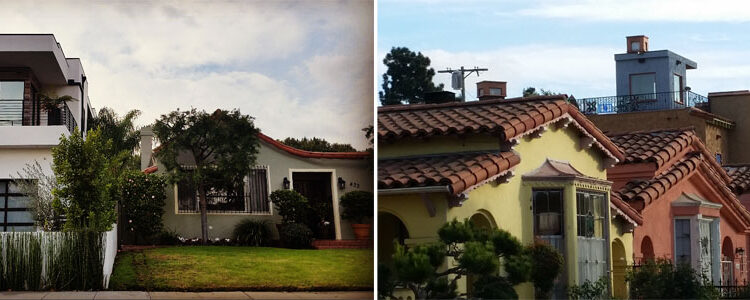
re:code, R1 Single-Family Variation Zones
What is re:code?
Re:code LA is the first comprehensive update to the City of Los Angeles’ zoning code since 1946. The new, web-based code will make it easier for users to navigate and understand land use regulations. One of the first components to be unveiled is a suite of new R1 single-family zones.
What do the new R1 Single-Family Variation Zones mean for me?
If you live in one of the neighborhoods protected by an Interim Control Ordinance (ICO), you will be among the first to benefit from the new R1 Zones. The new zones went into effect when the ICO expired in March 2017.
Neighborhoods not covered by the ICOs have protection from incompatible new construction through the amended Baseline Mansionization Ordinance until their Community Plans are updated with the new code.
The new R1 Variation Zones help manage the “form” or envelope of new buildings in order to maintain open space, reduce bulky new construction, and encourage context-sensitive design. The R1 Variation Zones are subsets of the R1 Zone that offer more detailed controls to better address the varying character of single-family neighborhoods throughout Los Angeles. Depending on your neighborhood’s needs, you can choose from a menu that ranges from less to more restrictive.
The new R1 Variation Zones mean:
- Greater transparency for residents and property owners about what can and cannot be built
- New construction and alterations to existing homes will be sensitive to their setting, including street, alley, and block patterns
- More thoughtful design in older neighborhoods, including maintained streetscapes, articulation of facades, and managed lot coverage
Nearly twenty Los Angeles neighborhoods received the new R1 Variation Zones as part of the initial rollout in March 2017, including Beverlywood, Citrus Square, Comstock Hills, Crestview, Fairfax, Inner Council District 5, East Venice, Faircrest Heights, Kentwood, La Brea Hancock, Larchmont Heights, Mar Vista, North Beverly Grove, North Beverlywood, Pacific Palisades, Picfair Village, South Hollywood, and Wilshire Vista.
Learn more about the R1 Variation Zones.
Background
The City of Los Angeles has embarked on the first comprehensive update of its zoning code since 1946. The initiative, re:code LA, will revise the existing code for the twenty-first century, making it web-accesible and resolving inconsistencies and ambiguities in the existing code.
As part of this broader initiative, the City is developing a suite of R1 single family zones tailored to existing neighborhood context.
Currently, most single-family homes occupy land zoned as R1. Together, R1 zones cover sixteen percent of the City. Because one size does not fit all in a city as diverse as Los Angeles, multiple layers of overlay zones have been applied to different neighborhoods in an ad hoc fashion. This has, in effect, created a myriad of modified R1 zones that manage change in different ways.
Under the current system, a house in an R1 zone could be modified by a height district, subject to Residential Floor Area Overlay, and be protected by an Interim Control Ordinance (ICO). In order to undertake a residential project, including routine work, a property owner would have to consult multiple sections of the municipal code.
When re:code LA is complete, a collection of R1 zones based on 'neighborhood typologies' will be available for individual communities to select and implement through the Community Plan process. Neighborhood typologies will consider features such as street pattern, building mass, garage placement, setbacks, and building height.
The new R1 zones will incorporate context-sensitive design standards for building coverage and envelope, Floor Area Ratio (FAR), height, and setbacks. These tailored solutions will help maintain a sense of open space, reduce bulkiness of new construction, and encourage compatibility with existing character.
Once the web-based code is available, property owners would simply need to search for their address in the code in order to view relevant requirements and regulations.
The City unveiled the new R1 zones for neighborhoods protected by the ICOs in March 2017. Neighborhoods not covered by the ICO will be subject to the amended Baseline Mansionization Ordinance until their Community Plans are revised to reflect the new code. City planners and community stakeholders will work together to determine which zones are most appropriate for individual neighborhoods.
re:code LA itself will not rezone neighborhoods, but will provide clearer and more accesible tools for planning efforts in the future.
As the new R1 zones are implemented, existing stop-gap measures, like ICOs, will no longer be necessary to regulate out-of-scale development in older residential neighborhoods. The new zones also open the door to an expanded neighborhood toolkit, including conservation districts.